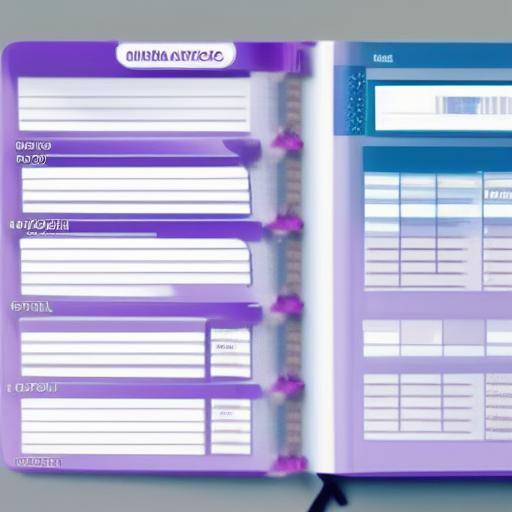
Burnout, or burned worker syndrome, is an increasingly common phenomenon in the workplace. This emotional, mental and physical exhaustion can affect anyone in the working environment, regardless of the type of work you do. It is important to emphasize that efficient planning and organization can play a crucial role in the prevention and mitigation of burnout. In this article, we will explore in depth the relationship between planning, burnout and productivity, as well as strategies and approaches to effectively address these issues.
Introduction
In the current working world, constant pressure and demands can lead to high levels of stress, exhaustion and demotivation. Planning and organization are key tools that can help professionals manage their responsibilities effectively, maximizing productivity and minimizing the risk of burnout. In this article, we will explore the importance of establishing effective planning habits and practices, as well as their impact on burnout prevention.
History and background
The relationship between planning, burnout and productivity is rooted in the evolution of the working environment and management practices. Throughout history, there have been significant changes in how these issues are addressed, and understanding their evolution provides a solid basis for addressing current challenges.
The need for planning and organization in the working environment dates back to the first forms of structured work, where the coordination of tasks and resources was essential for the success of projects and companies. Over time, theories and methodologies have been developed that support the importance of planning in improving efficiency and reducing labour stress.
The burnout concept, on the other hand, has its roots in the 1970s, when it began to recognize itself as a phenomenon related to chronic stress at work. Since then, extensive research has been undertaken to understand its causes, effects and forms of prevention.
The importance of productivity, of course, has been a central theme in business management. Resource optimization and the achievement of efficient results have been key objectives throughout history, and planning plays a crucial role in achieving these goals.
In-depth analysis
Recognition of the need for effective planning and understanding of burnout implications are critical in the current working environment. The impact of the lack of planning is reflected in the loss of efficiency and increased employee stress. In addition, exhaustion leading to burnout may have negative consequences for mental and physical health, as well as for work performance.
In contrast, successful planning implementation can promote a more balanced working environment, in which employees can effectively manage their workloads, set priorities and meet deadlines more efficiently. At the same time, an organizational culture that values planning can foster effective collaboration and communication, which contributes to a positive and healthy working environment.
The prevention of burnout through effective planning involves identifying and addressing the stressful factors of work, establishing appropriate limits, promoting autonomy and offering resources for professional development and self-care. Ultimately, appropriate planning and organization can help create a more sustainable and rewarding working environment for employees, while contributing to productivity improvement and the achievement of business goals.
Comprehensive review
Addressing the relationship between planning, burnout and productivity requires a comprehensive understanding of organizational dynamics, individual needs and labour market trends. The implementation of effective strategies for the promotion of planning and organization can vary according to industry and the working context. It is essential to consider best practices and adapt them to the specific needs of each working environment. In addition, data collection and monitoring of relevant metrics can provide valuable information on the effectiveness of planning initiatives and their impact on burnout prevention.
The development of training programmes and resources for time management, prioritization and problem solving can be an effective strategy to improve planning skills at the workplace. In addition, promoting labour flexibility and the balance between work and personal life can help reduce exhaustion and increase labour satisfaction.
Comparative analysis
By comparing planning, burnout and productivity, both overlapping areas and significant differences between these concepts are highlighted. While planning and productivity focus on resource optimization and goal achievement, burnout is more related to the negative consequences of overwork, stress and lack of balance in working and personal life.
It is important to recognize that effective planning can significantly contribute to burnout prevention by providing workers with the necessary tools and support to manage their labour responsibilities in a healthy and sustainable manner. At the same time, increased productivity can be a positive byproduct of successful implementation of consistent planning practices.
Practical advice and recommendations
To promote an effective planning culture and prevent burnout, a number of practical strategies can be implemented in the working environment. Some of these strategies include:
- Establish clear and attainable goals.
- Prioritize tasks effectively.
- Promote the establishment of healthy limits at work.
- Promote the balance between work and personal life.
- Providing resources and support for professional development.
- Promote open communication and collaboration between teams.
The implementation of these strategies can contribute significantly to the creation of a healthier and productive working environment, reducing the risk of burnout and improving employee satisfaction.
Industry perspectives and expert opinions
In exploring the importance of planning, burnout and productivity in the working environment, it is essential to consider the perspectives of experts on the subject. Industry professionals and leaders can provide valuable insights on the most effective practices and strategies, as well as share practical experiences related to the implementation of planning programmes in their organizations.
According to experts, effective planning is not only a key tool to increase productivity, but it is also essential to prevent exhaustion and promote mental health in the workplace. Organizations that prioritize planning and the organization are more likely to maintain motivated, committed and able teams to deal with labour challenges efficiently.
Case studies and practical applications
To illustrate the relevance of planning in burnout prevention, it is useful to analyse real cases and practical applications in specific work environments. Case studies that highlight the successful implementation of planning programs and their impact on burnout reduction can provide valuable lessons and inspirational examples for other professionals and organizations.
For example, companies that have adopted labour flexibility strategies, the promotion of autonomy and active support for personal development have seen significant reductions in the levels of stress and exhaustion among their employees. These cases demonstrate that investment in effective planning practices can generate tangible benefits for both employees and the company as a whole.
Future trends and predictions
As the working environment evolves, significant changes are seen in the way planning, burnout and productivity is addressed. Future trends are likely to reflect a greater focus on promoting the integral well-being of employees, including specific strategies for burnout prevention through improved planning and organization practices.
In addition, technology is expected to play an increasingly important role in supporting the effective planning and mitigation of burnout. Digital tools and applications that facilitate time management, remote collaboration and the identification of stressful factors at work could become key elements in the burnout prevention strategy in the future.
Conclusions and FAQs
In short, effective planning and organization play a key role in preventing burnout and promoting productivity in the working environment. By establishing sound planning practices, organizations can significantly contribute to the well-being and mental health of their employees, while improving overall efficiency and performance.
Frequently asked questions
Why is planning important in burnout prevention?
Effective planning helps employees manage their workloads in a more balanced way, establishing healthy priorities and limits, which contributes to reducing stress and exhaustion.
How can the lack of planning contribute to burnout?
Lack of planning can lead to overwork, incorrect prioritization of tasks and the feeling of abrum, which increases the risk of burnout among employees.
What are some practical strategies to promote workplace planning?
Establish clear goals, promote the balance between work and personal life, and provide professional development resources are some practical strategies to promote workplace planning.
How can technology support effective planning and burnout prevention?
Technology can provide tools and applications that facilitate time management, the identification of stressful factors at work and the promotion of efficient collaboration, thus contributing to the prevention of burnout.
What is the impact of planning on labour productivity?
Effective planning can improve efficiency and time management, which in turn contributes to increased labour productivity and achieving goals more effectively.
What role do leaders and managers play in promoting planning in the workplace?
Leaders and managers are responsible for fostering an organizational culture that values planning and organization, providing active support and resources to promote these habits among employees.
In conclusion, efficient planning and organization are critical to the prevention of burnout and the promotion of a healthy and productive working environment. By adopting practical strategies and fostering an organizational culture that values planning, organizations can contribute significantly to the integral well-being of their employees and to achieving sustainable business goals.






















































